

基于街景影像和深度学习技术的城市流动商贩空间分布制图
|
刘昱辰(2000—),男,湖南郴州人,硕士研究生,研究方向为地理信息科学,(E-mail)674599716@qq.com; |
收稿日期: 2022-12-29
修回日期: 2023-02-20
网络出版日期: 2023-07-10
基金资助
广州市科技计划项目“基于多源遥感的城市土地资源生命周期监测与分析研究”(202102020583)
国家自然科学基金项目“基于多源遥感与社会感知数据的城市土地利用发展路径监测与时空预测研究”(42071356)
Mapping of Spatial Distribution of Street Vendors Based on Street-View Images and Deep-Learning Technology
Received date: 2022-12-29
Revised date: 2023-02-20
Online published: 2023-07-10
流动商贩是城市社会生态系统中不可或缺的组成部分,高效治理流动商贩问题需要全面调查他们的经营规模和空间聚集信息。然而,传统方法在大规模流动商贩信息(尤其是他们的空间分布)的自动调查存在不足。文章提出一种基于街景影像和深度学习目标识别模型的流动商贩空间分布自动调查方法。按城市路网的固定间隔距离采集街景影像,通过人机交互的方式选取1 957张包含一个或以上商贩的图像建立流动商贩标签数据。构建基于YOLO v4深度神经网络的图像目标检测模型识别街景影像库中的流动商贩,模型的平均F 1值为0.77、mAP为0.67。精度能满足覆盖城市主要道路的流动商贩数量和位置调查的需要,进而应用核密度分布模型评估流动商贩的空间分布格局。以广州市的街头流动商贩为案例,通过所建立的自动调查模型在3 339 062幅街景影像中识别出26 119名街头商贩,结果表明,流动商贩在中心城区以多中心聚集模式分布,主要集中在地铁站、城中村附近等人流量大的区域,随着道路等级的下降其数量上升,而且流动商贩偏好分布于租金中等的地区。文章提出的方法有助于实现高效、低成本和城市尺度的街头摊贩分布制图,所得结果有助于制定和实施非正规经济的空间治理政策,并进一步为街景图像丰富且开放的城市的空间治理政策的改进和实施提供建议。识别结果可用于对从业者的区位偏好分析、“邻避效应”探究以及疏导区的划定提供决策参考依据。
刘昱辰 , 陈晓纯 , 刘轶伦 , 吴小芳 , 陈飞香 . 基于街景影像和深度学习技术的城市流动商贩空间分布制图[J]. 热带地理, 2023 , 43(6) : 1098 -1110 . DOI: 10.13284/j.cnki.rddl.003691
Street vendors are an indispensable part of the urban social ecosystem, but due to a lack of comprehensive understanding, many cities have adopted simple eviction policies, resulting in the gradual marginalization and stigmatization of the street economy. The efficient governance of street vendors requires the comprehensive investigation of their business scale and spatial distribution information. However, traditional methods have limitations in terms of automatically surveying large-scale street vendor information, particularly spatial distribution. This paper proposes a method for the automatic investigation spatial distribution of street vendors based on street-view images and a deep-learning object recognition model. Street-view images were collected at fixed intervals according to the urban road network, and 1,957 images containing one or more vendors were selected through human-machine interaction to establish street vendor label data. To achieve high recognition model accuracy, the category labels were subdivided into four categories: ground stalls, table stalls, tricycle stalls, and small truck stalls, based on the goods carriers used by street vendors. A deep neural-network-based image object detection model based on YOLO v4 was constructed to identify street vendors in the street-view image library, with an average F 1 value of 0.77 and an mAP of 0.67. The accuracy of the model was satisfactory for investigating the number and location of street vendors covering the main roads in the city and then applying a kernel density distribution model to evaluate the spatial distribution pattern of street vendors. Using street vendors in Guangzhou as a case study, the proposed automatic investigation model identified 26,119 street vendors from 3,339,062 street-view images. The results showed that the street vendors were distributed in a multicenter aggregation pattern in the central urban area, mainly concentrated in areas with high pedestrian traffic, such as subway stations and urban villages; their numbers increased as road grades decreases. Street vendors were mainly distributed in areas with medium rents. The proposed method is helpful for performing the efficient, low-cost, and city-scale mapping of street vendors; the results obtained provide suggestions for formulating and implementing spatial governance policies for the informal economy and further provide suggestions for improving and implementing spatial governance policies for open and diverse urban street-view images. The results can be used as a reference for the location preference analysis of practitioners, the exploration of NIMBY syndrome, and the determination of the formalization zone. Although street-view images have an insufficient spatiotemporal coverage, using them to perform street vendor investigations is a low-cost and efficient method compared with the use of traditional investigation methods and data sources. In addition, the method proposed in this article can be coupled with multitask deep learning algorithms to investigate additional dimensions of street vendor information, such as the sex, age, and type of business of street vendors. Relevant research needs to be conducted in the future.
表1 流动商贩分类及识别特征Table 1 The identification characteristics of four types of street vendors |
| 类别标签 | 类别名称 | 识别特征 | 标签数量/个 | 样例图 |
|---|---|---|---|---|
| C0 | 地面摊位 | 货物平铺于商贩面前的地面上 | 2 674 | 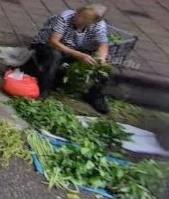 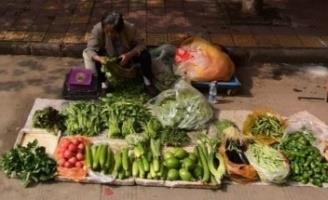 |
| C1 | 桌子摊位 | 货物被放置在一张简单的桌子上,部分配有遮阳伞或遮阳棚 | 3 040 | 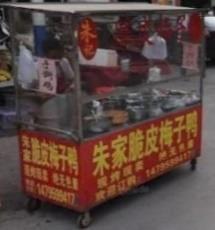 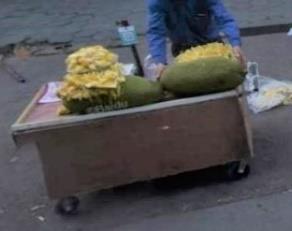 |
| C2 | 三轮车摊位 | 货物被放在一辆三轮车上,部分配有遮阳伞 | 1 605 | 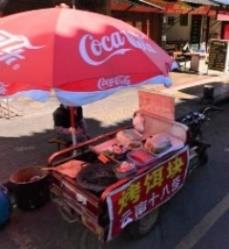 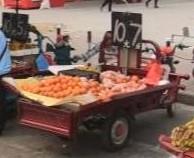 |
| C3 | 小货车摊位 | 货物被放在一辆小型货车或皮卡车上 | 226 | 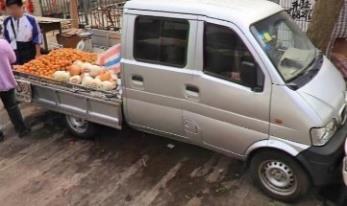 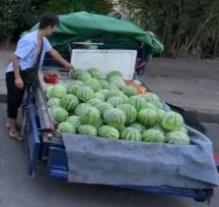 |
表2 不同置信度和IoU阈值的实验结果对比Table 2 Comparison of experimental results with different confidence and IoU thresholds |
| 序号 | 置信度阈值 | IoU阈值 | 召回度(R) | 精确度(P) | F 1 | mAP |
|---|---|---|---|---|---|---|
| 1 | 0.4 | 0.5 | 0.68 | 0.81 | 0.74 * | 0.63 |
| 2 | 0.5 | 0.5 | 0.71 | 0.85 | 0.77 | 0.67 |
| 3 | 0.5 | 0.6 | 0.62 | 0.71 | 0.66 | 0.53 |
| 4 | 0.5 | 0.7 | 0.50 | 0.48 | 0.49 | 0.34 |
| 5 | 0.5 | 0.8 | 0.25 | 0.17 | 0.20 | 0.77 |
| 6 | 0.6 | 0.5 | 0.60 | 0.89 | 0.71 | 0.57 |
| 7 | 0.7 | 0.5 | 0.51 | 0.92 | 0.64 | 0.49 |
| 8 | 0.8 | 0.5 | 0.38 | 0.93 | 0.52 | 0.37 |
|
图3 研究区街景影像的空间分布Fig.3 The study area and the spatial distribution of street view images |
图4 识别商贩的空间分布及标签框预测样例Fig.4 The spatial distribution of identified street vendors and the example of predicted label boxes |
图5 识别结果的核密度分布 [a. 研究区识别结果核密度分布概览;b. 中心城区局部放大图;c.商贩建议摆卖点与政府划定的疏导区的核密度概率分布]Fig.5 The kernel density of identification results[ a. The overview of kernel density distribution; b. The partial enlarged view of the central city; c. The probability distribution of kernel density of street vendors' suggested selling sites and official permitted sites] |
表3 道路等级、租金等级同流动商贩的数量关系Table 3 The quantitative relationship between road grade, rent grade and street vendors |
| 道路等级 | 流动商贩数量/个 | 租金等级 | 流动商贩数量/个 |
|---|---|---|---|
| 一级道路 | 4 004 | 低廉 | 2 496 |
| 二级道路 | 4 152 | 较低 | 8 040 |
| 三级道路 | 6 489 | 较高 | 13 893 |
| 四级道路 | 13 060 | 高昂 | 1 517 |

1 OpenStreetMap数据获取网址:https://www.openstreetmap.org
2 街景服务API获取网址:http://lbsyun.baidu.com
3 LabelImg项目网站:https://github.com/CSAILVision/LabelMeAnnotationTool
4 安居客数据获取网址:https://guangzhou.anjuke.com
刘昱辰:数据采集与处理、YOLO深度网络模型构建及验证、分析与图件制作、论文撰写;
陈晓纯:数据采集与处理、分析与图件制作;
刘轶伦:论文思路及方向指导、论文审阅及修改、经费支持;
吴小芳:数据处理与图件制作、YOLO深度网络模型构建及验证;
陈飞香:数据处理与图件制作。
|
Arietta S M, Efros A A, Ramamoorthi R, and Agrawala M. 2014. City Forensics: Using Visual Elements to Predict Non-Visual City Attributes. IEEE Transactions on Visualization and Computer Graphics, 20.
|
|
Boonjubun C. 2017. Conflicts over Streets: The Eviction of Bangkok Street Vendors. Cities, 70: 22-31.
|
|
Bromley R. 2000. Street Vending and Public Policy: A Global Review. International Journal of Sociology and Social Policy, 20: 1-28.
|
|
Bochkovskiy A, Wang C Y, and Liao H Y M. 2020. Yolov4: Optimal Speed and Accuracy of Object Detection. (2020-04-23) [2023-06-17]. https://arxiv.org/abs/2004.10934.
|
|
Charmes J. 2012. The Informal Economy Worldwide: Trends and Characteristics. Margin: The Journal of Applied Economic Research, 6: 103-132.
|
|
Cresswell T. 1996. In Place-out of Place: Geography, Ideology, and Transgression. Minneapolis: University of Minnesota Press.
|
|
Cai Y, Luan T, Gao H, Wang H, Chen L, Li Y, Sotelo M A, and Li Z. 2021. YOLOv4-5D: An Effective and Efficient Object Detector for Autonomous Driving. IEEE Transactions on Instrumentation and Measurement, 70: 1-13.
|
|
Deore P, and Lathia S. 2019. Streets as Public Spaces: Lessons from Street Vending in Ahmedabad, India. Urban Planning, 4: 138-153.
|
|
Garcia-Bolivar O E. 2006. Informal Economy: Is It a Problem, a Solution or Both? The Perspective of the Informal Business. (2006-03-06) [2022-12-31]. ]Bepress Legal Series. https://law.bepress.com/expresso/eps/1065/.
|
|
广州市人民政府.2023.广州市市容环境卫生管理规定.(2023-01-10)[2023-06-17].http://www.gd.gov.cn/zwgk/wjk/zcfgk/content/post_2531598.html.
Guangzhou Municipal People's Government. 2023. Guangzhou Municipal Regulations on Urban Environmental Sanitation Management. (2023-01-10) [2023-06-17]. http://www.gd.gov.cn/zwgk/wjk/zcfgk/content/post_2531598.html.
|
|
广州市统计局.2022.2022广州统计年鉴.(2022-10-25)[2023-06-17].https://lwzb.gzstats.gov.cn:20001/datav/admin/home/www_nj/ .[Guangzhou Statistical Bureau. 2022. 2022 Guangzhou Statistical Yearbook. (2022-10-25)[2023-06-17]. https://lwzb.gzstats.gov.cn:20001/datav/admin/home/www_nj/.]
|
|
广州市城市管理和综合执法局.2020.广州公布60个流动商贩临时疏导区.(2020-06-05)[2023-06-17]. http://cg.gz.gov.cn/zhzx/sjyw/content/post_5890802.html.[Guangzhou Urban Management and Comprehensive Law Enforcement Bureau. 2022. Guangzhou Announces 60 Temporary Areas for Regulating Street Vendors. (2020-06-05)[2023-06-17]. http://cg.gz.gov.cn/zhzx/sjyw/content/post_5890802.html.]
|
|
Huang G, Xue D, and Li Z. 2014. From Revanchism to Ambivalence: The Changing Politics of Street Vending in Guangzhou. Antipode, 46: 170-189.
|
|
Huang G, Xue D, and Wang Y. 2019. Governmentality and Spatial Strategies: Towards Formalization of Street Vendors in Guangzhou, China. International Journal of Urban and Regional Research, 43: 442-459.
|
|
He K, Zhang X, Ren S, and Sun J. 2015. Spatial Pyramid Pooling in Deep Convolutional Networks for Visual Recognition. IEEE Transactions on Pattern Analysis and Machine Intelligence, 37: 1904-1916.
|
|
胡鞍钢,杨韵新.2012.就业模式转变:从正规化到非正规化—我国城镇非正规就业状况分析.管理世界,(2):69-78.
Hu An'gang, and Yang Yunxin. 2012. Transformation of Employment Mode: from Regularization to Informalization: Analysis of Urban Informal Employment in China. Management World, (2): 69-78.
|
|
黄耿志,薛德升.2011.1990 年以来广州市摊贩空间政治的规训机制.地理学报,66(8):1063-1075 .
Huang Gengzhi, and Xue Desheng. 2011. Discipline and Anti-discipline: Spatial Politics of Urban Street Vending in Guangzhou since the 1990s. Acta Geographica Sinica, 66(8): 1063-1075.
|
|
黄耿志,薛德升.2015.非正规经济的正规化:广州城市摊贩空间治理模式与效应.城市发展研究,(3):51-57.
Huang Gengzhi, and Xue Desheng. 2015. Formalization of Informal Economy: Effects of the Policy of Permitted Vending Places for Street Vendors in Guangzhou. Urban Development Studies, (3): 51-57.
|
|
黄耿志,薛德升,金利霞.2016.城市流动摊贩的微区位选择机制——基于广州市200个摊贩访谈的实证研究.人文地理,31(1):57-64.
Huang Gengzhi, Xue Desheng, and Jin Lixia. 2016. Micro-Location Decision Making of Urban Street Vendors: Evidence from Interviews with 200 Vendors in Guangzhou. Human Geography, 31(1): 57-64.
|
|
黄耿志,薛德升,徐孔丹,杨燕珊,陈昆仑.2019.中国大城市非正规公共空间治理——对城市流动摊贩空间疏导模式的后现代反思.国际城市规划,34(2):47-55.
Huang Gengzhi, Xue Desheng, Xu Kongdan, Yang Yanshan, and Chen Kunlun. 2019. Governance of Informal Public Space in Urban China: A Post-modern Critique of Spatial Formalization of Urban Street Vending. Urban Planning International, 34(2): 47-55.
|
|
Ki D, and Lee S. 2021. Analyzing the Effects of Green View Index of Neighborhood Streets on Walking Time Using Google Street View and Deep Learning. Landscape and Urban Planning, 205, 103920.
|
|
Kamete A Y. 2018. Pernicious Assimilation: Reframing the Integration of the Urban Informal Economy in Southern Africa. Urban Geography, 39: 167-189.
|
|
Lemessa S D, Watabaji M D, Yismaw M A, and Tadesse A B. 2021. Evening Street Vending and the Tragic Living Conditions of Vendors: The Case of Eastern Ethiopia Region. Cities, 108: 102947.
|
|
Liu S, Qi L, Qin H, Shi J, and Jia J. 2018. Path Aggregation Network for Instance Segmentation. (2018-09-18) [2023-06-17]. https://arxiv.org/abs/1803.01534.
|
|
Linzner R, and Lange U. 2013. Role and Size of Informal Sector in Waste Management-A Review. Proceedings of the Institution of Civil Engineers-Waste and Resource Management, 166: 69-83.
|
|
Liu W, Anguelov D, Erhan D, Szegedy C, Reed S, Fu C Y, and Berg A C. 2016. Ssd: Single Shot Multibox Detector. (2016-12-29) [2023-06-17]. https://arxiv.org/abs/1512.02325.
|
|
Law S, Paige B, and Russell C. 2019. Take a Look Around: Using Street View and Satellite Images to Estimate House Prices. ACM Transactions on Intelligent Systems and Technology (TIST), 10: 1-19.
|
|
Li C, Huang Y, Shen Y, and Xu L. 2022. Spatiotemporal Patterns and Mechanisms of Street Vending from the Social Sensing Perspective: A Comparison between Law-Enforcement Reported and Residents Complain Events. Cities, 124: 103597.
|
|
Maneepong C, and Walsh J C. 2013. A New Generation of Bangkok Street Vendors: Economic Crisis as Opportunity and Threat. Cities, 34: 37-43.
|
|
Mahabir R, Schuchard R, Crooks A, Croitoru A, and Stefanidis A. 2020. Crowdsourcing Street View Imagery: A Comparison of Mapillary and OpenStreetCam. ISPRS International Journal of Geo-Information, 9: 341.
|
|
Morera Á, Sánchez Á, Moreno A B, Sappa Á D, and Vélez J F. 2020. SSD vs. YOLO for Detection of Outdoor Urban Advertising Panels under Multiple Variabilities. Sensors, 20: 4587.
|
|
马宁,朱美芬.2010.和谐社会视域下发展“地摊经济”的思考.法制与社会,(25):100-101.
Ma Ning, and Zhu Meifen. 2010. Reflections on the Development of "Street Vendors Economy" from the Perspective of Harmonious Society. Legal System and Society, (25): 100-101.
|
|
Naik N, Kominers S D, Raskar R, Glaeser E L, and Hidalgo C A. 2017. Computer Vision Uncovers Predictors of Physical Urban Change. Proceedings of the National Academy of Sciences, 114: 7571-7576.
|
|
Ren S, He K, Girshick R, and Sun J. 2016. Faster R-CNN: Towards Real-Time Object Detection with Region Proposal Networks. IEEE Transactions on Pattern Analysis and Machine Intelligence, 39: 1137-1149.
|
|
Redmon J, and Farhadi A. 2018. Yolov3: An Incremental Improvement. (2018-08-08) [2023-06-17]. https://arxiv.org/abs/1804.02767.
|
|
Redmon J, Divvala S, Girshick R, and Farhadi A. 2016. You Only Look Once: Unified, Real-Time Object Detection. (2016-05-09) [2023-06-17]. https://arxiv.org/abs/1506.02640.
|
|
Sung C. 2011. Drawing the Line: Spatial Street Vendor Management in Ho Chi Minh City. Cambridge: Massachusetts Institute of Technology.
|
|
Silverman B W, and Jones M C. 1989. E. Fix, and JL Hodges (1951): An Important Contribution to Nonparametric Discriminant Analysis and Density Estimation: Commentary on Fix and Hodges (1951). International Statistical Review, 57(3): 233-247.
|
|
Suel E, Polak J W, Bennett J E, and Ezzati M. 2019. Measuring Social, Environmental and Health Inequalities Using Deep Learning and Street Imagery. Scientific Reports, 9: 1-10.
|
|
Schneider F, and Enste D H. 2013. The Shadow Economy: An International Survey. Cambridge: Cambridge University Press.
|
|
Turner S, and Schoenberger L. 2012. Street Vendor Livelihoods and Everyday Politics in Hanoi, Vietnam: The Seeds of a Diverse Economy?. Urban Studies, 49: 1027-1044.
|
|
Wilson D C, Velis C, and Cheeseman C. 2006. Role of Informal Sector Recycling in Waste Management in Developing Countries. Habitat International, 30: 797-808.
|
|
Wang C Y, Liao H Y M, Wu Y H, Chen P Y, Hsieh J W, and Yeh I H. 2019. CSPNet: A New Backbone That can Enhance Learning Capability of CNN. (2019-11-27) [2023-06-17]. https://arxiv.org/abs/1911.11929.
|
|
Yao Y, Zhang J, Qian C, Wang Y, and Guan Q. 2021. Delineating Urban Job-Housing Patterns at a Parcel Scale with Street View Imagery. International Journal of Geographical Information Science, 35(10): 1927-1950.
|
|
Yatmo Y A. 2008. Street Vendors as 'Out of Place' Urban Elements. Journal of Urban Design, 13: 387-402.
|
|
Yin L, and Wang Z. 2016. Measuring Visual Enclosure for Street Walkability: Using Machine Learning Algorithms and Google Street View Imagery. Applied Geography, 76: 147-153.
|
|
Yatmo Y A. 2009. Perception of Street Vendors as 'Out of Place' Urban Elements at Day Time and Night Time. Journal of Environmental Psychology, 29: 467-476.
|
|
尹铎,蔡慕言,梁金多,朱竑,高权.2019.广州城市流浪乞讨者的空间管治与日常生活实践.地理科学,39(3):450-458.
Yin Duo, Cai Muyan, Liang Jinduo, Zhu Hong, and Gao Quan. 2019. The Everyday Life Practice and Space Control of Homeless in Guangzhou. Scientia Geographica, 39(3): 450-458.
|
|
Zhu Y, and Newsam S. 2016. Land Use Classification Using Convolutional Neural Networks Applied to Ground-Level Images. (2016-09-21). [2023-06-17]. https://arxiv.org/abs/1609.06653.
|
|
Zhang F, Zu J, Hu M, Zhu D, Kang Y, Gao S, Zhang Y, and Huang Z. 2020. Uncovering Inconspicuous Places Using Social Media Check-ins and Street View Images. Computers, Environment and Urban Systems, 81: 101478.
|
|
张延吉,张磊,吴凌燕.2017.流动商贩的空间分布特征及与正规商业的分布关系——基于距离测度方法的数量研究.地理学报,72(4):618-632.
Zhang Yanji, Zhang Lei, and Wu Lingyan. 2017. Spatial Distribution of Street Vending and Its Spatial Relationship with Formal Commerce: Quantitative Research Using Distance-Based Methods. Acta Geographica Sinica, 72(4): 618-632.
|
|
中国政府网.2020.李克强称赞地摊经济、小店经济:是人间的烟火,是中国的生机.(2020-06-01)[2023-06-17] .https://www.gov.cn/xinwen/2020-06/01/content_5516569.htm.[China Government Net. 2020. Govt to Support Stalls, Small Stores. (2020-06-01) [2023-06-17] http://english.www.gov.cn/premier/news/202006/01/content_WS5ed4ec73c6d0b3f0e9499372.html.]
|
/
| 〈 |
|
〉 |